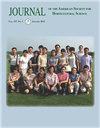Classifying Cider Apple Germplasm Using Genetic Markers for Fruit Acidity
IF 1.1
4区 农林科学
Q3 HORTICULTURE
Journal of the American Society for Horticultural Science
Pub Date : 2021-05-11
DOI:10.21273/JASHS05056-21
引用次数: 4
Abstract
The organic acid concentration in apple (Malus ×domestica) juice is a major component of hard cider flavor. The goal of this study was to determine if the malic acid markers, Ma1 and Q8, could classify the titratable acidity concentration in cider apple accessions from the United States Department of Agriculture Malus germplasm collection into descriptive classifications. Our results indicate that for diploid genotypes, the Ma1 marker alone and the Ma1 and Q8 markers analyzed together could be used to predict cider apple acidity (P < 0.0001). Alone, the Ma1 marker categorized acidity into low (<2.4 g⋅L−1), medium (2.4–5.8 g⋅L−1), and high (>5.8 g⋅L−1) groups. The combination of Ma1 and Q8 markers provided more specificity, which would be useful for plant breeding applications. This work also identified a significant difference (P = 0.0132) in acidity associated with ploidy. On average, the triploids accessions had 0.33 g⋅L−1 higher titratable acidity than the diploid accessions. Based on the results of this work, we propose a genetics-based classification system for cider apples with the acidity component defined by the Ma1 and Q8 markers.利用果实酸度遗传标记对苹果酒种质进行分类
苹果汁中的有机酸浓度是硬苹果酒风味的主要组成部分。本研究的目的是确定苹果酸标记Ma1和Q8是否可以将美国农业部苹果种质资源中苹果酒苹果材料的可滴定酸度浓度分类为描述性分类。我们的研究结果表明,对于二倍体基因型,单独的Ma1标记以及一起分析的Ma1和Q8标记可以用于预测苹果酒的酸度(P<0.0001)。单独的Ma1标记将酸度分为低(5.8 g·L−1)组。Ma1和Q8标记的组合提供了更多的特异性,这将有助于植物育种应用。这项工作还发现了与倍性相关的酸度的显著差异(P=0.0132)。平均而言,三倍体材料的可滴定酸度比二倍体材料高0.33g·L−1。基于这项工作的结果,我们提出了一个基于遗传学的苹果酒分类系统,其酸度成分由Ma1和Q8标记定义。
本文章由计算机程序翻译,如有差异,请以英文原文为准。
求助全文
约1分钟内获得全文
求助全文
来源期刊
CiteScore
3.80
自引率
0.00%
发文量
31
审稿时长
2 months
期刊介绍:
The Journal of the American Society for Horticultural Science publishes papers on the results of original research on horticultural plants and their products or directly related research areas. Its prime function is to communicate mission-oriented, fundamental research to other researchers.
The journal includes detailed reports of original research results on various aspects of horticultural science and directly related subjects such as:
- Biotechnology
- Developmental Physiology
- Environmental Stress Physiology
- Genetics and Breeding
- Photosynthesis, Sources-Sink Physiology
- Postharvest Biology
- Seed Physiology
- Postharvest Biology
- Seed Physiology
- Soil-Plant-Water Relationships
- Statistics

 求助内容:
求助内容: 应助结果提醒方式:
应助结果提醒方式:


